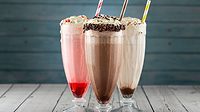![]()
Packaging Trends of the Future
Package innovation is one
of the most difficult, but most visible, investments beverage companies can
make. Of the 988 product introductions measured this year by Marketing
Intelligence Service’s Productscan, only 16 offered packaging
innovation claims. But there have been stand-outs in the industry that are
leading the future of beverage packaging.
One of the newest packages is the self-heating can for
WP Beverage Partners’ Wolfgang Puck Gourmet Lattes. Last year, the
company introduced ready to drink lattes, meant to be served cold, and
added to the line up this fall with a package that allows them to be served
hot by heating the product to 140° F in six to eight minutes.
Using OnTech technology, the package is essentially a
can within a can. The inner can contains crushed limestone and the outer
can contains the beverage. The package also has a sealed disc containing
water that, when a consumer pushes a button on the bottom of the can, is
released into the limestone, causing a thermal reaction that heats the
beverage.
Thermal ink used on the package label changes color
when the product is heated to the right temperature, and the glue that
holds a tamper-proof overcap on the top of the can melts so the top can be
turned and the pull-tab accessed.
The products are available in four flavors —
Rich Espresso, French Vanilla, Rich Mocha and Rich Caramel, and will retail
for $2.29 to $2.79 for single cans, or $8.99 per four-pack.
On the other side of the thermostat, aluminum bottles,
such as those created by CCL Container and Exal C2C, continue to gain
attention in the beverage business, not only for their unique appearance,
but for their ability to chill a beverage faster and keep it cold longer.
Absolut Spirits Co. used an aluminum bottle for its Grapefruit and
Cranberyraz-flavored Danzka Vodka rollout, and says the bottle chills 50
minutes faster than glass packaging.
According to Absolut, “From wines to beer to
spirits, manufacturers are introducing cool new designs that combine clever
technology and a growing trend toward functional packaging that helps
consumers keep spirits cold.”
New looks for wine
Wine is perhaps the fastest-changing packaging
category, with many wineries, even those on the high end, exposing consumes
to screw-caps, cans, boxes and even PET. Wineries Down Under seem to be
more adventuresome with their packaging, and many of the innovations,
including wine in a can, are making their way from Australia to the United
States. Woomba Wines of Australia last year rolled out Aussie Wines in
four-packs of 250-ml. cans in Chardonnay, Cabernet Shiraz and Sweet White
Blend varieties. The company says the packages were developed with an inner
lining to prevent tainted flavor, and are primarily targeted toward
restaurants and bars with by-the-glass wine programs.
Also in Australia, Amcor Ltd. recently announced it
would invest $8 million to install metal screw-cap equipment for the wine
industry at its Thomastown, Victoria, facility. The company says it will
more than double the production of wine screw-caps, which are gaining
acceptance for their ability to eliminate the flavors imparted by cork
closures. Amcor says screw-caps now represent 20 percent of wine industry
packaging in Australia and nearly 50 percent in New Zealand.
The concept of wine in a box has almost put its
bargain-brand image behind it, and with new shapes and sizes has made
inroads in the U.S. market. In addition to the traditional 5-liter size,
Scholle Corp., Northlake, Ill., has created bag-in-box wine packaging in
3-liter and even 1.5-liter sizes that are promoted for their portability
and stability after opening.
Constellation Brands took boxed wine packaging even
smaller this year and introduced Almaden Red Sangria in a 500-ml. aseptic
carton with a pull-tab. The company said the product was for on-the-go
consumers and was perfect for picnics and other away-from-home activities.
Fetzer Vineyards took its newest packaging cue from
the beer industry, and in January will begin shipping Valley Oaks Merlot,
Chardonnay and White Zinfandel in 187-ml. SurShot multi-layer,
injection-molded PET, created by Owens-Illinois. The wines will be
distributed through airlines, poolside venues such as resorts and hotels,
sports arenas and other outlets where glass is prohibited.
Fetzer says oxygen barriers in the bottles, which
feature screw caps, allow the company to keep the wines preservative-free.
“It’s a consumer-driven first,” says Fetzer marketing
executive Lou Willsea. “Retailers have told us consumers are looking
for ways to simplify life while obtaining high quality. For picnics,
ball-game tailgaters, golf courses, poolside and more, Fetzer’s PET
package makes it easy to relax, refresh and renew.”
Jolt of energy
Jolt Cola, perhaps the original energy drink, was
recently recharged with a new resealable “Battery Bottle,”
created by Rexam Beverage Can Americas. The 23.5-ounce package is the first
resealable aluminum container of its size, according to brand owner Wet
Planet Beverages, Rochester, N.Y. In addition to the new can top, the
package incorporates thermo-chromatic ink that changes color when the
beverage is chilled. As the cola is consumed, the ink returns to its
original color, showing the consumer how much liquid is left in the can.
Initial reaction to the can has been positive says Wet
Planet President and Chief Executive Officer CJ Rapp, who reports the
company has “never had a better reaction” to a product. BI





